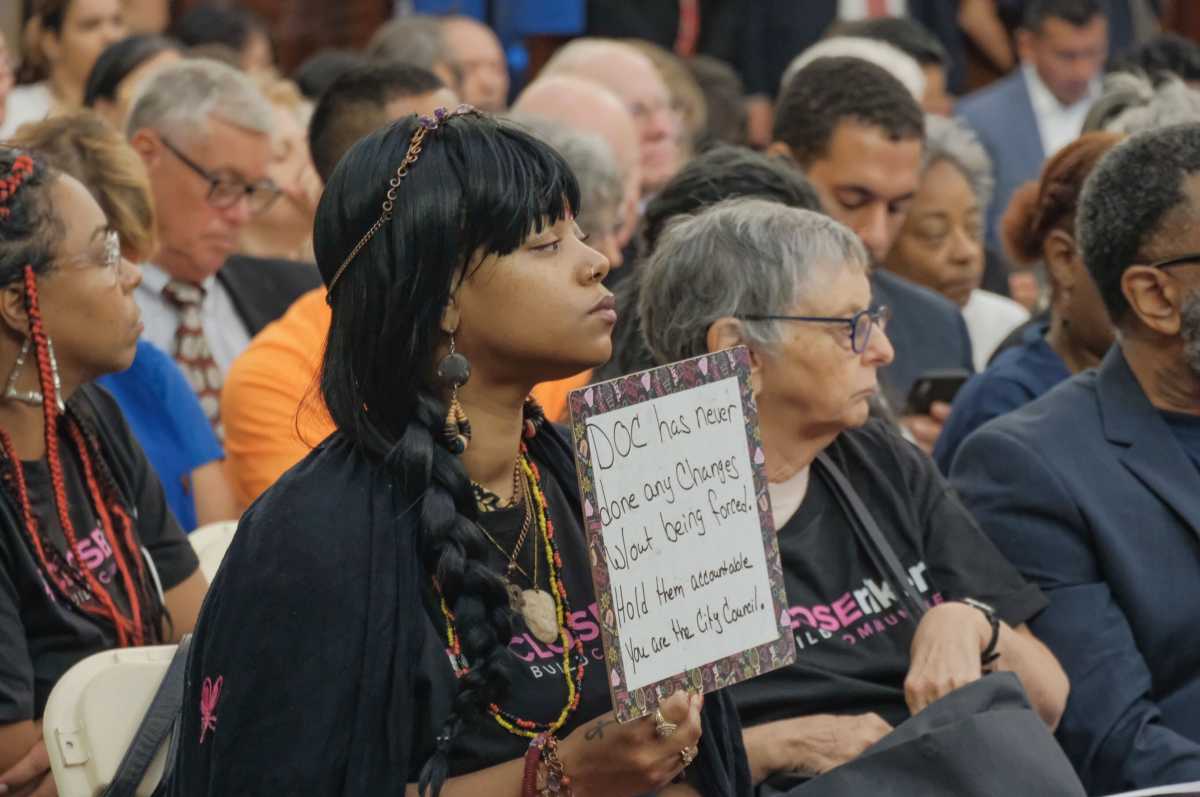The City Council chamber was nearly filled to capacity Thursday as lawmakers and criminal justice advocates spoke out on the mayor’s plan to replace Rikers Island with borough-based jails.
The Sept. 5 hearing was the only chance for City Council members on the Land Use Committee and the public to question officials from the mayor’s office on the proposal. Activists lined the boundaries of City Hall to make a statement in favor of closing Rikers Island without the borough-based facilities.
Councilman Rafael Salamanca cornered Dana Kaplan, deputy director of Close Rikers and Justice Initiatives (MOCJ), into sharing that the decision as to where the jails would be located preceded any form of public outreach and the decision was settled upon by “the powers that be” without community input.
Kaplan said closing Rikers will reduce the number of people in city detention from 11,000 to around 4,000.
“We’re talking about moving from 11 active jails across the city to four,” Kaplan said. “The goals of this [plan] are to build a city that is more fair…This is an incredible reduction in the number of people in detention and it’s historic.”
With chatter earlier in 2019 centered around the possible implications of a jail in Kew Gardens, Elizabeth Glazer, Director of the Mayor’s Office of Criminal Justice, said it is rare for a crime to be committed outside one of DOC’s smaller facilities because of the surveillance and general lack of foot traffic around jails.
Kaplan also added that MOCJ had looked into how a borough-based jail would impact property values, a primary concern for the Queens Neighborhood Advisory Committee, and they determined that other jail facilities have not been a detriment to homeowners.
Kew Gardens currently has a jail: the Queens House of Detention. But this facility is more or less only used to stage detainees for court appearances adjacent to the jail. The Queens Detention Complex, which was shuttered years ago, would be demolished and replaced by a new, multi-story jail under the mayor’s plan.
Cynthia Brann, commissioner for the Department of Corrections, said the jail system needs to reflect the agency’s “modern values expressed commitment to closing Rikers Island for the age of facilities currently in use.
A significant capital investment would bring DOC’s facilities in a state of good repair, but Brann argued that it would not resolve cultural and logistical issues posed by keeping detainees in one centralized location.
Brann also pointed out that the switch to a smaller detention system would have a negative impact on DOC, many of whom will be laid off.
She could not say for certain exactly how many DOC staff members would be facing unemployment by 2026 but that the agency had held open forums.
The Kew Gardens facility will fall in line with the rest of the other three facilities.
It will rise around 20 stories and house no more than 1,150 detainees. It will include community space at the ground level and offer better accommodations for family visitation.
But the key difference for the Queens facility will be that it will be the only facility to house women as well with a maternity ward and nursery.
Judge Jonathan Lippman’s testimony in favor of the borough-based approach to detention was consistent with the fact that he led the commission brought into existence by Melissa Mark-Viverito during her term as Council Speaker in 2017.
“There is no viable path to closing Rikers that doesn’t include borough-based facilities, Lippman said. “Rejecting the plan will mean Rikers continues to exist for generations to come. That cannot be our legacy. This is, in the end, a moral issue. The Rikers Island jails disproportionately impact black and brown communities and are an affront to humanity. We must shutter Rikers and once and for all remove this stain from the soul of our great city.”
Another contentious discussion topic was regarding the Rikers annex simply known as “the barge.”
MOCJ officials said the timeline for closing this is in the envelope of the rest of the close Rikers plan; to be away from the island entirely by 2026.




































